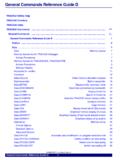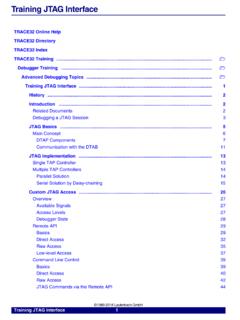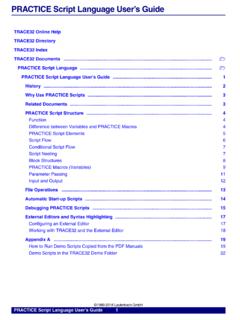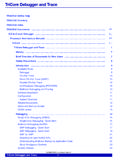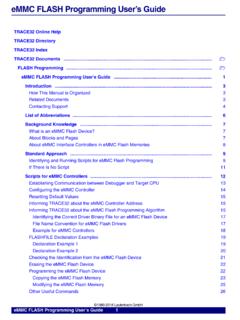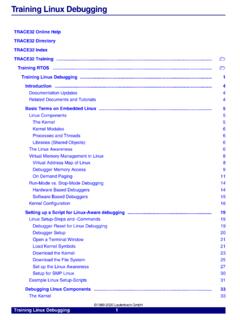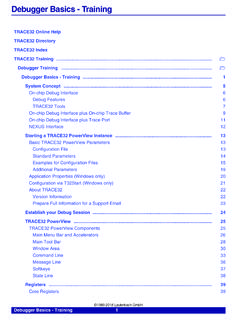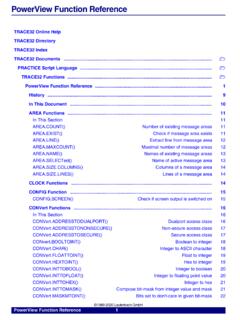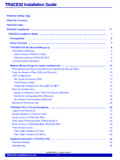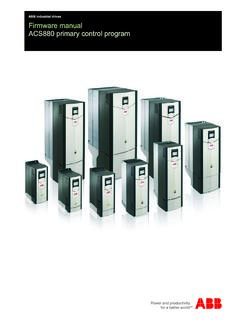Transcription of Training JTAG Interface - Lauterbach
1 Training jtag Interface 1 1989-2018 Lauterbach GmbHTraining jtag InterfaceTRACE32 Online Help TRACE32 Directory TRACE32 Index TRACE32 Training .. Debugger Training .. Advanced Debugging Topics .. Training jtag Interface ..1 History ..2 Introduction ..2 Related Documents2 Debugging a jtag Session3 jtag Basics ..5 Main Concept6 DTAP Components7 Communication with the DTAB11 jtag Implementation ..13 Single TAP Controller13 Multiple TAP Controllers14 Parallel Solution14 Serial Solution by Daisy-chaining15 Custom jtag Access.
2 26 Overview27 Available Signals27 Access Levels27 Debugger State28 Remote API29 Basics29 Direct Access32 Raw Access35 Low-level Access37 Command Line Control39 Basics39 Direct Access40 Raw Access42 jtag Commands via the Remote API44 Training jtag Interface 2 1989-2018 Lauterbach GmbHTraining jtag InterfaceVersion 14-Nov-2018 History12-Aug-15 Chapter jtag Design Recommendations removed, because the information was not most embedded CPU architecture implementations, the jtag port is used by the debugger to Interface the chip for debugging one or more cores.
3 The normal user will probably not need to know details of the jtag implementation unless there is a need to debug several daisy-chained jtag TAP controllers or to access special test functions or configurations via jtag that are not implemented in the debugger Training manual explains the basics of jtag in case of a single TAP controller or several daisy-chained TAP controllers and how to perform a custom access to the jtag port by using the TRACE32 DocumentsThis Training does not focus on any specific architecture, so the best document to find any architecture- and CPU specific information is the corresponding Processor Architecture Manual. Not only ARM users will find the ARM jtag Interface Specifications ( ) interesting since it contains information applicable to any device and general information on the TRACE32 debug cable Architecture ManualProcessor Architecture ManualsARM jtag Interface Specifications ARM jtag Interface Specifications ( )Remote API Manual API for Remote Control and jtag Access ( )Command Reference for Letter J General Commands Reference Guide J ( ) Training jtag Interface 3 1989-2018 Lauterbach GmbHDebugging a jtag SessionFor debugging any jtag communication the use of a logic analyzer such as the TRACE32 PowerProbe is recommended.
4 TRACE32 PowerProbeConnection details Training jtag Interface 4 1989-2018 Lauterbach GmbHBy using this tool it is not only possible to record the signals but also decode the jtag protocol for a better interpretation. The jtag decoder is built-in but also available as source-code allowing to extend the analysis by a higher-level decoder for custom use: Training jtag Interface 5 1989-2018 Lauterbach GmbHJTAG BasicsJTAG is the name used for the IEEE standard entitled Standard Test Access Port and Boundary-Scan Architecture for test access ports (TAP) used for testing printed circuit boards (PCB) using boundary is the acronym for Joint Test Action Group, the name of the group of people that developed the IEEE functionality usually offered by jtag is Debug Access and Boundary Scan.
5 Debug Access is used by debugger tools to access the internals of a chip making its resources and functionality available and modifiable, registers, memories and the system state. Boundary Scan is used by hardware test tools to test the physical connection of a device, on a PCB. Although this is usually not the task of a debugger tool the TRACE32 debugger offers mechanisms to access the jtag TAP in a generic way, to perform boundary scan using a PRACTICE script or a custom the TAP (Test Access Port) access itself is generic for all architectures, the functionality implemented behind jtag is different for each following chapter explains all necessities for accessing a jtag TAP. For a complete description of jtag see the IEEE standard. Training jtag Interface 6 1989-2018 Lauterbach GmbHMain ConceptJTAG is defined as a serial communication protocol and a state machine accessible via a TAP.
6 The DTAB (Debug and Test Access Block) is implemented on the target chip as a passive device that never sends data without DTAB mainly consists of the following: The TAP (Test Access Port) with its physical connections (signals) to the external world. The TAP Controller (a 16-state state machine). One IR (Instruction Register) and several DRs (Data Registers). The Debug Bus for communication with the on-chip debug standardDevice specific functionality Training jtag Interface 7 1989-2018 Lauterbach GmbHDTAP ComponentsTAP (Test Access Port)The TAP defines the Interface between the DTAB and the debug tool. The jtag Port is the physical connector on the PCB where the debug cable is IEEE standard defines the following TAP signals, used for the serial communication and driving the TAP controller ( jtag state machine):The TMS and TDI line are sampled by the DTAP on each rising edge on the TCK line.
7 The TDO line changes its value after a falling edge on the TCK and Data RegistersThe functionality of the DTAB is accessible via different instructions stuffed into the Instruction Register. By loading an instruction, the corresponding Data Register is selected for access, providing and/or accepting data according to the selected a few instructions are defined by the IEEE standard, and only a few of them are mandatory, the BYPASS instruction (mandatory) for use in daisy-chained multi-core configurations IDCODE instruction (not mandatory) for identifying a deviceUnused instruction codes can be freely implemented by the device width of the IR is not specified by the jtag standard but needs to be the same for all instructions of a specific device.
8 Since the DR is selected according to the loaded instruction the DR width is Data Inserial data from debugger to targetTDOTest Data Outserial data from target to debuggerTCKTe s t C l o c kTMSTest Mode Selectcontrols the TAP controller state transitionsTRSTTest Resetoptional, resets the TAP controller Training jtag Interface 8 1989-2018 Lauterbach GmbHThe following schematic shows the connection of the input signals with the DTAB and the selection of the Data Register depending on the content of the Instruction Register: Training jtag Interface 9 1989-2018 Lauterbach GmbHTAP ControllerThe IEEE standard defines a 16-state state machine called the TAP controller to control several actions:Each state of the TAP controller can be reached by a sequence of bits transmitted via the TMS line depending on the current state.
9 Normally a DR or IR shift access starts from the pause parking position, changes to one of the shift states where data is transmitted and ends up in the pause parking position parking position: state the TAP controller holds while waiting for the next shift operation. Training jtag Interface 1 0 1989-2018 Lauterbach GmbHThe following states of the TAP controller are of importance: Test Logic Reset sets the Instruction Register to its reset value (IDCODE or BYPASS). This state can be reached from any other state by shifting five times 1 on TMS. Some CPUs do also reset the DTAB and/or the on-chip debug logic when this state is entered. As a result an active debug connection might get lost, if this state is driven by a PRACTICE script or a custom application.
10 Run-Test/ Idle and Select DR-Scan are used by most debuggers as pause parking position. In the Shift-IR state the debug tool shifts an instruction into the Instruction Register. The instruction is activated once the TAP controller reaches the Update-IR state. In the Shift-DR state the debug tool shifts data to/from the Data Register selected by the currently loaded BusThe debug functionality is usually not implemented in the DTAB but realized as a separate IP block. Thus the implementation of the Debug Bus and the on-chip debug logic (Debug System) is device some CPUs the access to the Debug Bus is enabled by a dedicated jtag instruction. Communication is then completely handled via a dedicated Data Register. The DTAB just enables accesses to the on-chip debug logic by using the DR on-chip components may be accessible with their own jtag instruction, ETM/ ETB, MCDS or an auxiliary processor.
